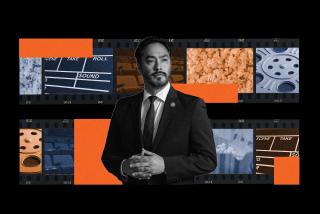Film academy shines the spotlight on ‘Treasures’ from the past
With a little bit of luck and a lot of sleuthing, a long-lost 1911 film short from pioneering filmmaker Lois Weber was found and restored and will have its world premiere Thursday in a joint presentation from the Academy of Motion Picture Arts and Sciences and the Library of Congress.
The historic “On the Brink,” in which Weber also appears, is part of “Film Treasures of the Library of Congress” at the Linwood Dunn Theater in Hollywood, which will feature a few complete films as well as excerpts from 18 other titles, according to David Pierce, assistant chief of the Library’s Packard Campus for Audio-Visual Conservation and the program’s curator.
For the record:
6:20 a.m. Sept. 3, 2018An earlier version of this article attributed the final quotation, which starts, “The great thing about the digital revolution,” to David Pierce. The speaker was John Bailey.
“That’s an interesting discovery because that came to the library through the academy [archive],” said Pierce of the film short. “The academy was working with John Hampton, who you remember [as the first owner] of the Silent Movie Theatre.”
Hampton’s nitrate prints were among those the academy sent to the Library of Congress, which has collected and preserved 124 years of film, including the five-second “Fred Ott’s Sneeze” from 1894 — the oldest film in its collection.
“It was only in the last 10 years we were going through and identifying some films in the collection, particularly the John Hampton collection,” said Pierce. “There was this example of a film that looked like it was from the early 1910s. By going through it and looking at the plot and comparing it with what was in the trade press synopses, our nitrate vault manager was able to identify it as a lost Lois Weber film.”
The evening will also include the only surviving footage of two Technicolor musical shorts, rare footage of Clara Bow and the Marx Brothers, and works from such superstars as Clark Gable, composer George Gershwin and novelist Ernest Hemingway. There will also be a teaser of the library’s restoration of Thomas Edison’s 1910 “Frankenstein.”
“We’re trying to show the breadth of what we have,” said Pierce. “Thanks to copyright and our work with the studios, we have a very good collection of commercial studio type movies. What we’ll be talking about more is the breadth of the collection — the things if not for the Library of Congress would never have been collected and preserved.”
John Bailey, president of the film academy and a cinematographer (“The Big Chill,” “In the Line of Fire”), will co-host Thursday’s program with Carla Hayden, the current Librarian of Congress and the first woman and African American to hold that position.
“I feel that we are reestablishing on multiple fronts a stronger and stronger ongoing communication with the Library of Congress, the Packard Center, our own film archive and the [academy’s] Margaret Herrick Library,” said Bailey, who has had a long connection with the library, being a member of its National Film Preservation Board.
“This is a reintroduction of the Library of Congress to the West Coast,” noted Hayden. “It is similar to what you would find in a library,” she said. “You have nonfiction, you have mysteries, you have fun books. And these films are also projecting American history — a visual literacy. Some people are more textual in terms of how they receive information and other people are more visual in terms of the visual cues you get. There’s a growing recognition that visual literacy is just as significant and can be a gateway to people that might not use text in the same way.”
The library, noted Pierce, “tries to be a good partner. We have our own audio preservation laboratories that can handle every recorded sound format. We have a video preservation lab that can handle every cassette-based video format and most of the open-reel formats. On the film side, we have a photo chemical film laboratory that’s still copying our nitrate as well as digital scanning and restoration systems to be able to create digital copies and provide broader access.
“One of the really amazing things is how many archives and libraries and sources some of these films are found in in bits and pieces,” he added.
Among the collections that can be viewed on the Library of Congress website (www.loc.gov) are “America at Work: America at Leisure, 1894-1915,” “Theodore Roosevelt: His Life and Times on Film” and “Before and After the Great Earthquake and Fire: Early Films of San Francisco, 1897-1916.” Since 1989, under the National Film Preservation Act, the Librarian of Congress each year names 25 films to the National Film Registry that are “culturally, historically or aesthetically significant” and at least 10 years old.
“The great thing about the digital revolution,” Bailey said, “is that we’ve been able to save so many things. You look at these movies that are 100 to 110 years old and they seem so present, so alive and real. It is our history. It’s just so emotionally engaging to see this stuff.”
Film Treasures from the Library of Congress
Where: Linwood Dunn Theater, 1313 Vine St., Hollywood
When 7:30 p.m. Thursday
Tickets: The program is sold out, but there will be a standby line that evening.
WATCH: Video Q&A’s from this season’s hottest contenders »
More to Read
Only good movies
Get the Indie Focus newsletter, Mark Olsen's weekly guide to the world of cinema.
You may occasionally receive promotional content from the Los Angeles Times.











